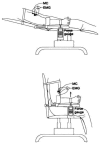In-vivo measurement of muscle tension: dynamic properties of the MC sensor during isometric muscle contraction
- PMID: 25256114
- PMCID: PMC4208254
- DOI: 10.3390/s140917848
In-vivo measurement of muscle tension: dynamic properties of the MC sensor during isometric muscle contraction
Abstract
Skeletal muscle is the largest tissue structure in our body and plays an essential role for producing motion through integrated action with bones, tendons, ligaments and joints, for stabilizing body position, for generation of heat through cell respiration and for blood glucose disposal. A key function of skeletal muscle is force generation. Non-invasive and selective measurement of muscle contraction force in the field and in clinical settings has always been challenging. The aim of our work has been to develop a sensor that can overcome these difficulties and therefore enable measurement of muscle force during different contraction conditions. In this study, we tested the mechanical properties of a "Muscle Contraction" (MC) sensor during isometric muscle contraction in different length/tension conditions. The MC sensor is attached so that it indents the skin overlying a muscle group and detects varying degrees of tension during muscular contraction. We compared MC sensor readings over the biceps brachii (BB) muscle to dynamometric measurements of force of elbow flexion, together with recordings of surface EMG signal of BB during isometric contractions at 15° and 90° of elbow flexion. Statistical correlation between MC signal and force was very high at 15° (r = 0.976) and 90° (r = 0.966) across the complete time domain. Normalized SD or σN = σ/max(FMC) was used as a measure of linearity of MC signal and elbow flexion force in dynamic conditions. The average was 8.24% for an elbow angle of 90° and 10.01% for an elbow of angle 15°, which indicates high linearity and good dynamic properties of MC sensor signal when compared to elbow flexion force. The next step of testing MC sensor potential will be to measure tension of muscle-tendon complex in conditions when length and tension change simultaneously during human motion.
Figures







Similar articles
-
MC sensor--a novel method for measurement of muscle tension.Sensors (Basel). 2011;11(10):9411-25. doi: 10.3390/s111009411. Epub 2011 Sep 30. Sensors (Basel). 2011. PMID: 22163702 Free PMC article.
-
Shear wave elastography characterizes passive and active mechanical properties of biceps brachii muscle in vivo.J Mech Behav Biomed Mater. 2023 Jan;137:105543. doi: 10.1016/j.jmbbm.2022.105543. Epub 2022 Nov 2. J Mech Behav Biomed Mater. 2023. PMID: 36371993
-
Association between contraction-induced increases in elbow flexor muscle thickness and distal biceps brachii tendon moment arm depends on the muscle thickness measurement site.J Appl Biomech. 2014 Feb;30(1):134-9. doi: 10.1123/jab.2012-0145. J Appl Biomech. 2014. PMID: 24676520
-
Comparison of a piezoelectric contact sensor and an accelerometer for examining mechanomyographic amplitude and mean power frequency versus torque relationships during isokinetic and isometric muscle actions of the biceps brachii.J Electromyogr Kinesiol. 2006 Aug;16(4):324-35. doi: 10.1016/j.jelekin.2005.07.013. Epub 2005 Oct 21. J Electromyogr Kinesiol. 2006. PMID: 16243542
-
Conceptualizing myocardial contractility as an emergent property that characterizes myocardial contraction.Front Physiol. 2025 Apr 16;16:1499536. doi: 10.3389/fphys.2025.1499536. eCollection 2025. Front Physiol. 2025. PMID: 40308567 Free PMC article. Review.
Cited by
-
Electrically Elicited Force Response Characteristics of Forearm Extensor Muscles for Electrical Muscle Stimulation-Based Haptic Rendering.Sensors (Basel). 2020 Oct 4;20(19):5669. doi: 10.3390/s20195669. Sensors (Basel). 2020. PMID: 33020415 Free PMC article.
-
Individualized muscle architecture and contractile properties of ankle plantarflexors and dorsiflexors in post-stroke individuals.Front Bioeng Biotechnol. 2024 Nov 26;12:1453604. doi: 10.3389/fbioe.2024.1453604. eCollection 2024. Front Bioeng Biotechnol. 2024. PMID: 39659988 Free PMC article.
-
Estimating the Effects of Awareness on Neck-Muscle Loading in Frontal Impacts with EMG and MC Sensors.Sensors (Basel). 2020 Jul 15;20(14):3942. doi: 10.3390/s20143942. Sensors (Basel). 2020. PMID: 32679857 Free PMC article.
-
Preliminary study of reliability of transcutaneous sensors in measuring intraabdominal pressure.Sci Rep. 2022 May 18;12(1):8268. doi: 10.1038/s41598-022-12388-x. Sci Rep. 2022. PMID: 35585106 Free PMC article.
-
A Novel Approach to Measuring Muscle Mechanics in Vehicle Collision Conditions.Sensors (Basel). 2017 Jun 14;17(6):1389. doi: 10.3390/s17061389. Sensors (Basel). 2017. PMID: 28613265 Free PMC article.
References
-
- Lieber R.L. Methods for Human Muscle Force Determination, Skeletal Muscle Structure, Function, Plasticity. 3rd. Lipincott Williams & Wilkins; Baltimore, MD, USA: 2010. pp. 119–124.
-
- Schantz P., Randall-Fox E., Hutchison W., Tyden A., Astrand P.O. Muscle fibre type distribution, muscle cross-sectional area and maximal voluntary strength in humans. Acta Physiol. Scand. 1983;117:219–226. - PubMed
-
- Rugg S.G., Gregor R.J., Mandelbaum B.R., Chiu L. In vivo moment arm calculations at the ankle using magnetic resonance imaging (MRI) J. Biomech. 1990;23:495–501. - PubMed
-
- Ito M., Akima H., Fukunaga T. In vivo moment arm determination using b-mode ultrasonography. J. Biomech. 2000;33:215–218. - PubMed
MeSH terms
LinkOut - more resources
Full Text Sources
Other Literature Sources

